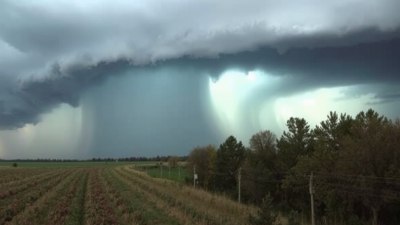The Role of Tiny Ice Particles in Starting Massive Thunderstorms
Explore how tiny ice particles contribute to the formation of intense thunderstorms and their broader implications.

Image by pvproductions on Freepik
Thunderstorms are complex atmospheric phenomena that can bring about severe weather conditions, including heavy rainfall, strong winds, hail, and lightning. One of the fundamental processes in the development of these storms is the interaction of tiny ice particles in the atmosphere. Understanding the role of these ice particles—often referred to as 'ice nuclei'—is crucial for meteorologists and climate scientists alike. In this article, we will delve into the science behind how tiny ice particles contribute to the initiation of massive thunderstorms, their formation processes, and the implications for weather prediction and climate change.
Formation of Ice Particles in the Atmosphere
The journey of tiny ice particles begins when water vapor in the atmosphere cools and condenses into supercooled droplets. These droplets can exist in liquid form at temperatures below freezing. When supercooled droplets encounter ice nuclei—tiny particles such as dust, salt, or other particulate matter—they can freeze and form ice crystals. This process is known as heterogeneous nucleation. The presence of these ice nuclei is vital for the formation of ice particles in clouds, as pure water droplets would require much colder temperatures to freeze spontaneously.
Ice Particles and Cloud Development
As ice crystals form, they interact with surrounding water droplets, leading to a process known as riming, where supercooled droplets collide with ice crystals and freeze onto them. This growing ice particle can become heavy enough to fall towards the Earth's surface, but on its way down, it can further collide with more supercooled droplets, growing in size. This process, referred to as the Bergeron-Findeisen process, is fundamental in the transformation of water vapor to precipitation and is critical in the development of thunderstorms.
The Initiation of Thunderstorms
For thunderstorms to initiate, a combination of factors must align, including sufficient moisture, atmospheric instability, and, significantly, the presence of ice particles within the cloud. When a thunderstorm begins, warm, moist air rises in the atmosphere, creating a strong updraft. This upward movement brings ice particles higher into the atmosphere, where temperatures are much colder, allowing them to grow. As these ice particles accumulate and enlarge, they can become part of a larger storm cloud.
Updrafts and Thunderstorm Dynamics
The dynamics of a thunderstorm are heavily influenced by the interaction between ice particles and warm air. The updrafts created by the rising warm air can be intense, reaching speeds of over 40 miles per hour in severe storms. These powerful updrafts lift the ice particles, and as they rise, the ice particles experience lower temperatures and continue to grow. Eventually, when the weight of these ice particles becomes too great for the updraft to support, they fall, leading to precipitation.
The Role of Ice Particles in Downdrafts
As ice crystals fall, they can also interact with surrounding air, leading to downdrafts—regions of sinking air in a thunderstorm. The presence of ice particles can enhance the downdraft by cooling the surrounding air, which increases its density and causes it to sink rapidly. This downdraft can further contribute to the storm's development, leading to additional heating and lifting of air, which can sustain the storm.
Lightning and Ice Particles
One of the most striking features of thunderstorms is lightning, which is believed to originate from the interactions between ice particles within the storm. As ice particles collide and transfer charge, they generate static electricity. The continuous growth and collision of these particles can create a significant build-up of electrical energy. When the potential difference between charged regions becomes great enough, it results in a discharge of electricity, manifesting as lightning. This intricate interplay between ice particles and electrical charge is crucial for understanding thunderstorm electrification.
Influence on Weather Patterns
The influence of tiny ice particles extends beyond individual thunderstorms; they can impact local and regional weather patterns. For instance, the formation of large storm systems can create feedback loops where moisture and temperature changes lead to the development of more thunderstorms. Understanding how ice particles are involved in these processes can greatly improve weather forecasting models. By incorporating the dynamics of ice particles, meteorologists can better predict storm intensity and rainfall amounts, which is essential for preparing communities for severe weather.
Climate Change and Ice Nuclei
As global temperatures rise due to climate change, the behavior of ice nuclei and their contribution to thunderstorms may also be affected. Changes in atmospheric composition, moisture availability, and temperature gradients could alter the processes involved in cloud formation and, consequently, storm development. Moreover, shifts in the distribution of particulate matter in the atmosphere may affect the availability of ice nuclei, which can have cascading effects on thunderstorm frequency, duration, and intensity.
Research and Future Directions
Ongoing research is aimed at exploring the complex interactions between ice nuclei and thunderstorm dynamics. Scientists use advanced modeling techniques and observational data to investigate how varying concentrations of ice nuclei can influence storm characteristics. Understanding these relationships may lead to improvements in our ability to predict severe weather events and inform strategies for mitigating their impact on communities.
The role of tiny ice particles in starting massive thunderstorms is a key area of interest for climatologists and meteorologists. These ice nuclei serve as the building blocks for ice crystal formation, which is integral to the development and sustenance of thunderstorms. Through the interactions of ice particles with moisture and atmospheric dynamics, they trigger updrafts and downdrafts, influence lightning formation, and impact broader weather patterns. As we confront the challenges posed by climate change, it is essential to continue research in this area to enhance our understanding of these powerful weather phenomena and improve our predictive capabilities. In the face of an ever-changing climate, understanding the intricacies of thunderstorm formation, driven by the smallest of particles, may prove crucial for safeguarding lives and properties.











